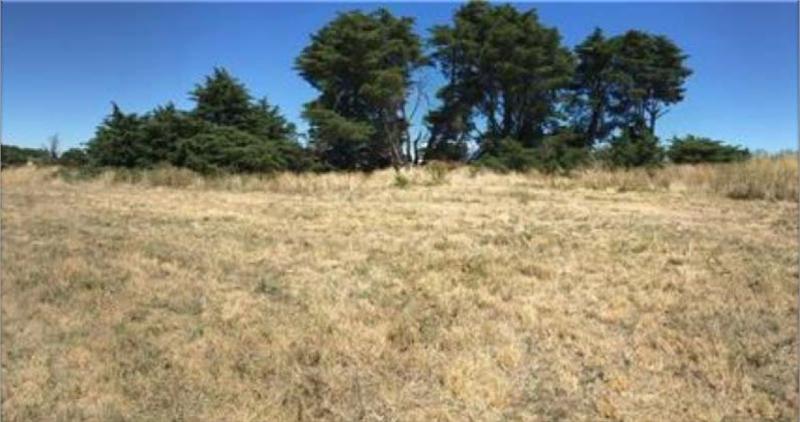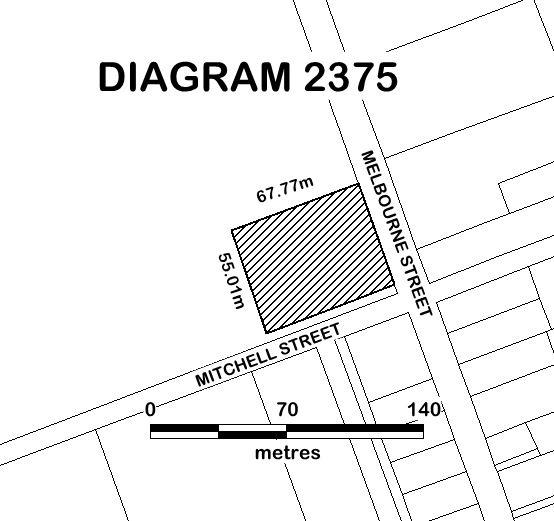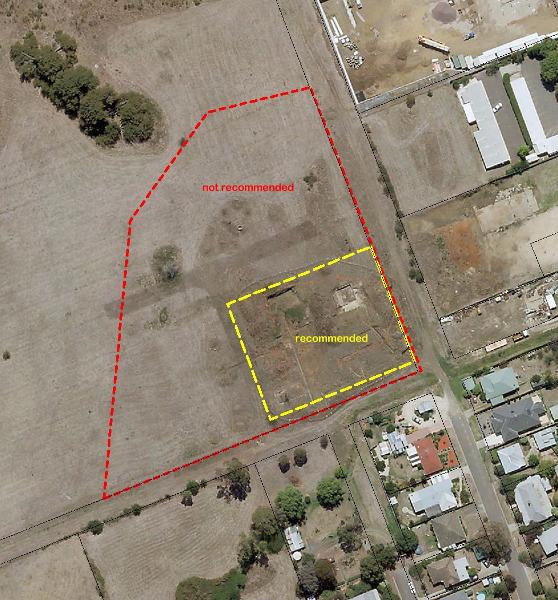KILMORE BREWERY SITE
57 MELBOURNE STREET KILMORE, MITCHELL SHIRE
-
Add to tour
You must log in to do that.
-
Share
-
Shortlist place
You must log in to do that.
- Download report




Statement of Significance
What is significant?
How is it significant?
Why is it significant?
-
-
KILMORE BREWERY SITE - History
_Background - brewing technologies
Brewing involves treating the grain through soaking, heating, drying and milling to convert the starch released from the grain into sugars that can be fermented/converted into alchol. This process involves three basic steps:
1.Malting or soaking the grain (called steeping), allowing it to germinate, then drying it in a kiln, and end the process by milling the grain
2.Mashing which involves soaking/agitating the milled grain in hot water in a mash tun and the resultant liquid produced is called wort
3.Fermenting of the wort with hops, sugars and yeast over a period of days or weeks to produce alcoholic beer.Brewing in Victoria
The origins of a local brewing industry in Victoria can be traced back to 1838, when Thomas Capel, was credited as the first brewer in Melbourne, and sold 'Capel's beer entire' from the Britannia Brewery, near the Queens Wharf. Later that same year, John Moss, a publican, began to manufacture ale at the rear of his hotel, the Ship Inn, in Flinders Lane. By the time that Charles Joseph La Trobe arrived in Melbourne in 1839 to serve as Superintendent, a third brewery had been established. In 1841 there was still only three breweries all operating at 'full blast'. The first Mayor of Melbourne, Henry Condell, was a brewer by trade, and he operated from premises in Little Bourke Street until they were destroyed in a spectacular fire in 1845.By 1850, there were seven breweries in Melbourne and another seven in regional Victoria. Early Australian beer was exclusively ale which was top-fermented and quick-maturing, and made without hops, as the cultivation and importation of hops was difficult. Early brewers experienced difficulties as the greatest demand was in hot weather when it was virtually impossible to make good beer. Traditional English brewing techniques had to be adapted to suit the warmer climate and the lack of efficient refrigeration. The quality of the final product varied considerably and local beer deteriorated rapidly. The lack of suitable cool storage facilities, and the inherent difficulties of road transport, meant that the beer could not be transported great distances without considerable spoilage.
At this time ale and porter was stored and carted in 'hogsheads'. A hogshead was a large wooden barrel, made of staves, that held 54 gallons of ale. Some of the smallest breweries only produced around twenty hogsheads per week. A beer stored in hogshead did not travel well. If the carting distance was more than fifty miles, the beer often went sour. This meant that a town brewery tended to cater for a local market. In this context it was important for beer to be brewed locally in regional centres.
During the 1850s and 1860s the number of regional breweries increased exponentially in Victoria. Brewing became an important industry in rural centres that blossomed during the 1860s with some 80 breweries operating in 34 towns. This regional brewery boom was also fuelled by population growth due to the gold rushes. By 1871, there were 125 breweries across Victoria, of which a staggering 80 per cent were located outside of Melbourne. In the late nineteenth century, regional Victoria was estimated to have the highest concentration of breweries in any area of regional Australia.
The establishment of the Kilmore Brewery
The Kilmore Brewery was established by 1852 in Victoria's earliest inland town. In 1850, Stephen Neilson purchased lots 9 and 10 on Mitchell Street and by late December 1852 he had built a substantial brewery on this land. The Argus reported that the brewery was of 'a somewhat extensive scale' and consisted of a brew house, malt house, a kiln with iron floor, 4.3 metre cellar in the rock situated within one acre of land. It was the intention of Neilson to brew both ale and porter. The brewery's water supply came from a well that had been sunk to the depth of 32 metres (100 feet). The brewery was sold in 1852, and an advertisement on 10 December in the Argus read:
The Kilmore Brewery, with one acre of land; Stubbs & Sons are by Mr Neilson, the proprietor, to sell by public auction - the Kilmore Brewery is complete. Brew house, malt house, a kiln with iron floor, cellar in the rock, 14 feet deep, well of excellent water, 100 feet deep, with casks, coppers, coppers, a quantity of barley, and everything complete, and an acre of land in the bargain.A later abstract of Sales by Auction in the Argus notes that the Kilmore Brewery had 'one acre of land, fire-proof safes, window-glass, oaten hay, [and] clothes'. Between 1853 and 1865 the Kilmore Brewery had a number of owners - Neilson registered a lease to William Smith in February 1853, who then sublet the brewery to William Risk in November 1853. In August 1855 Howard John Alt purchased the brewery but in early 1858, John Alt died and on March 1858 the property was leased to a David Moffatt to be held in trust for Alt's eight year-old son. In December 1864 the lease was transferred to James Tierney and his brother-in-law John Fynn who traded as Fynn and Company.
Development of the Kilmore Brewery
John Fynn became the mayor of Kilmore in 1865 and after two years of success at the brewery, purchased or leased an adjoining piece of land (to the east, lot 8) upon which they erected 'very neat and commodious buildings consisting of a kiln, malt-house and a large bin for soaking or steeping malt'. The new buildings were described as having ' a splendid cement-made floor, which cost nearly £50 to complete . The kiln too, is a beautiful piece of work, and malts about 40 bushels at a time'. In 1881 John Fynn died the brewery was sold as part of his estate to a purchaser, Mr Brady. It would appear that between the 1860s and 1881 Fynn & Co. did not substantially expand the area of the brewing operations beyond an acre. The paddock at the rear of the brewery was purchased as farm land in 1881. Four years later, this land was advertised for lease for grazing as 'the splendid paddock adjoining Kilmore Brewery'.During the mid to late-nineteenth century regional breweries came and went due to competition, lack of sufficient venture capital to update buildings, or the requirement for new brewing equipment, as more sophisticated manufacturing process became available. In 1888, the Kilmore Free Press informed its readers that the Kilmore Brewery had been sold to a Melbourne syndicate. In 1891 the business was apparently still doing well. The Argus reported:
. the Kilmore brewery appears to be making excellent headway against the best Metropolitan establishments. Not only is it found in several of the leading Melbourne hotels, but experts pronounce it equal in colour, taste and body to any beer produced in the colony. the cellars [at the brewery] are cut clean out of the solid rock, so that any required temperature can be obtained even during the hottest weather.In 1894 the Kilmore Brewery was described as:
. a collection of quaint buildings on the hillside to the west of Sydney Street. Its moss grown shingled roof shows its age. The principal cellar is cut out of the face of the hill, reminding me of wine cellars in France . The manager, Mr W.H. Dyer .. Lives near the brewery, in a house surrounded by a white plastered wall, over which rose bushes are clustered.Changes in the brewing industry
The Kilmore Brewery thrived for several decades from the 1850s and was described in the mid-1890s as 'like a villa in the suburbs of some French county town'. Its success, however, gradually became vulnerable to a number of factors affecting regional breweries. The dramatic expansion of Victoria's railway network in the 1870s and 80s enabled the large metroplitan breweries to send their products into regional Victoria. Faced with this competition, and the move into lager manufacture, many regional breweries were no longer economical. By 1890 less than half of the registered regional breweries from the 1870s were still operating. At this time the future of beer drinking also became tied to the manufacture of lager which brought with it the need and expense of bottling and refrigeration.The economic downturn of the 1890s depression and the new Commonwealth Beer and Excise Act 1901 also hastened the decline of regional breweries. This Act regulated the making and selling of beer and its provisions, regarded by many as draconian, meant that the brewing industry has to restructure and consolidate to survive. Large breweries bought out smaller ones, and ownership became concentrated into fewer businesses in Melbourne and larger regional centres like Bendigo and Ballarat. In Melbourne, five breweries merged in 1907 to form the giant Carlton and United Breweries, and in Sydney only two breweries remained: Tooths and Tooheys.
The demise of the Kilmore Brewery
The Kilmore Brewery was affected by these changes, and in addition, an essential building was destroyed by a natural disaster in 1902. Two news articles describe the destruction of the brewery's cooling house by 'slight earthquake' or a 'hurricane' leaving only 'the chimney standing' . [with] . sheets of iron blown a considerable distance'. A new building was proposed and there is evidence that some land was levelled for its construction. But there was a dispute over payment in respect to the drawing up of the plans for a new building, and construction did not proceed. After the brewery ceased operation, the land was repurposed for agriculture. In 1938 the place was described thus: 'The buildings of the old time have gone and where all was bustle and activity silence remains. A few of the later buildings are standing.'KEY REFERENCES USED TO PREPARE ASSESSMENT
Kilmore Brewery Complex (H7822-0080), Archaeological Excavation, Biosis Research Pty Ltd (2011)
The Breweries of Australia: A History, Keith M Deutsher (1999)
Brewing in Bendigo, Brian Rhule and Mike Butcher, in Bendigo at Work: An Industrial History, edt by Mike Butcher (2005)
Online newspapers including the Argus, Kilmore Free Press and Bendigo Advertiser
State Library of Victoria - Online images
CMP Former Yorkshire Brewery, 1-21 Robert Street Collingwood Conservation Management Plan, Produced for SMA Projects March 2011 Lovell ChenKILMORE BREWERY SITE - Assessment Against Criteria
The Kilmore Brewery Site is significant at the State level for the following reasons:
The Kilmore Brewery operated from the early 1850s and was one of the earliest breweries outside Melbourne. The site contains archaeological evidence of historical interest, some of which is not currently visible or disturbed, that has a high likelihood of yielding information through further detailed investigation. This site can provide insight into the practices of early brewing and malting industries and their workforces in early colonial Victoria. [Criterion C]
KILMORE BREWERY SITE - Plaque Citation
The Kilmore Brewery was one of the earliest breweries outside Melbourne. It operated from the early 1850s and until 1903. This site contains archaeological evidence of the brewing and malting industries and their workforces in early colonial Victoria.
KILMORE BREWERY SITE - Permit Exemptions
General Exemptions:General exemptions apply to all places and objects included in the Victorian Heritage Register (VHR). General exemptions have been designed to allow everyday activities, maintenance and changes to your property, which don’t harm its cultural heritage significance, to proceed without the need to obtain approvals under the Heritage Act 2017.Places of worship: In some circumstances, you can alter a place of worship to accommodate religious practices without a permit, but you must notify the Executive Director of Heritage Victoria before you start the works or activities at least 20 business days before the works or activities are to commence.Subdivision/consolidation: Permit exemptions exist for some subdivisions and consolidations. If the subdivision or consolidation is in accordance with a planning permit granted under Part 4 of the Planning and Environment Act 1987 and the application for the planning permit was referred to the Executive Director of Heritage Victoria as a determining referral authority, a permit is not required.Specific exemptions may also apply to your registered place or object. If applicable, these are listed below. Specific exemptions are tailored to the conservation and management needs of an individual registered place or object and set out works and activities that are exempt from the requirements of a permit. Specific exemptions prevail if they conflict with general exemptions. Find out more about heritage permit exemptions here.Specific Exemptions:Landscape
. Landscape maintenance works provided the activities do not involve the removal or destruction of any sub-surface archaeological artefacts or deposits.
Fire Suppression Duties
. Fire suppression and fire-fighting duties provided the works do not involve the removal or destruction of any sub-surface archaeological artefacts or deposits.
Weed and Vermin Control
. Weed and vermin control activities provided the works do not involve the removal or destruction of any significant sub-surface archaeological artefacts or deposits.
. Removal of plants listed as noxious weeds in the Catchment and Land Protection Act 1994.
Public Safety and Security
. Public safety and security activities provided the works do not involve the removal or destruction of any sub-surface archaeological artefacts or deposits;
Signage and Site Interpretation
. The erection of non-illuminated signage for the purpose of ensuring public safety or to assist in the interpretation of the heritage significance of the place or object and which will not adversely affect fabric including landscape or archaeological features of the place or obstruct significant views of and from heritage values or items.
. Signage and site interpretation products must be located and be of a suitable size so as not to obscure appreciation of the place.
. Signage and site interpretation products must be able to be later removed without causing damage to the significant fabric of the place.
Note: The development of signage and site interpretation products must be consistent in the use of format, text, logos, themes and other display materials.
KILMORE BREWERY SITE - Permit Exemption Policy
It should be noted that Permit Exemptions can be granted at the time of registration (under s.42(4) of the Heritage Act). Permit Exemptions can also be applied for and granted after registration (under s.66 of the Heritage Act)
General Condition 1
All exempted alterations are to be planned and carried out in a manner which prevents damage to the fabric of the registered place or object.
General Condition 2
Should it become apparent during further inspection or the carrying out of works that original or previously hidden or inaccessible details of the place or object are revealed which relate to the significance of the place or object, then the exemption covering such works shall cease and Heritage Victoria shall be notified as soon as possible.
General Condition 3
All works should ideally be informed by Conservation Management Plans prepared for the place. The Executive Director is not bound by any Conservation Management Plan, and permits still must be obtained for works suggested in any Conservation Management Plan.
General Condition 4
Nothing in this determination prevents the Heritage Council from amending or rescinding all or any of the permit exemptions.
General Condition 5
Nothing in this determination exempts owners or their agents from the responsibility to seek relevant planning or building permits from the relevant responsible authority, where applicable.
-
-
-
-
-
KILMORE COURT HOUSE
 Victorian Heritage Register H1471
Victorian Heritage Register H1471 -
WHITBURGH COTTAGE
 Victorian Heritage Register H0774
Victorian Heritage Register H0774 -
THE TOWERS
 Victorian Heritage Register H0564
Victorian Heritage Register H0564
-
..esterville
 Yarra City
Yarra City -
1 Alfred Crescent
 Yarra City
Yarra City -
1 Barkly Street
 Yarra City
Yarra City
-
-












